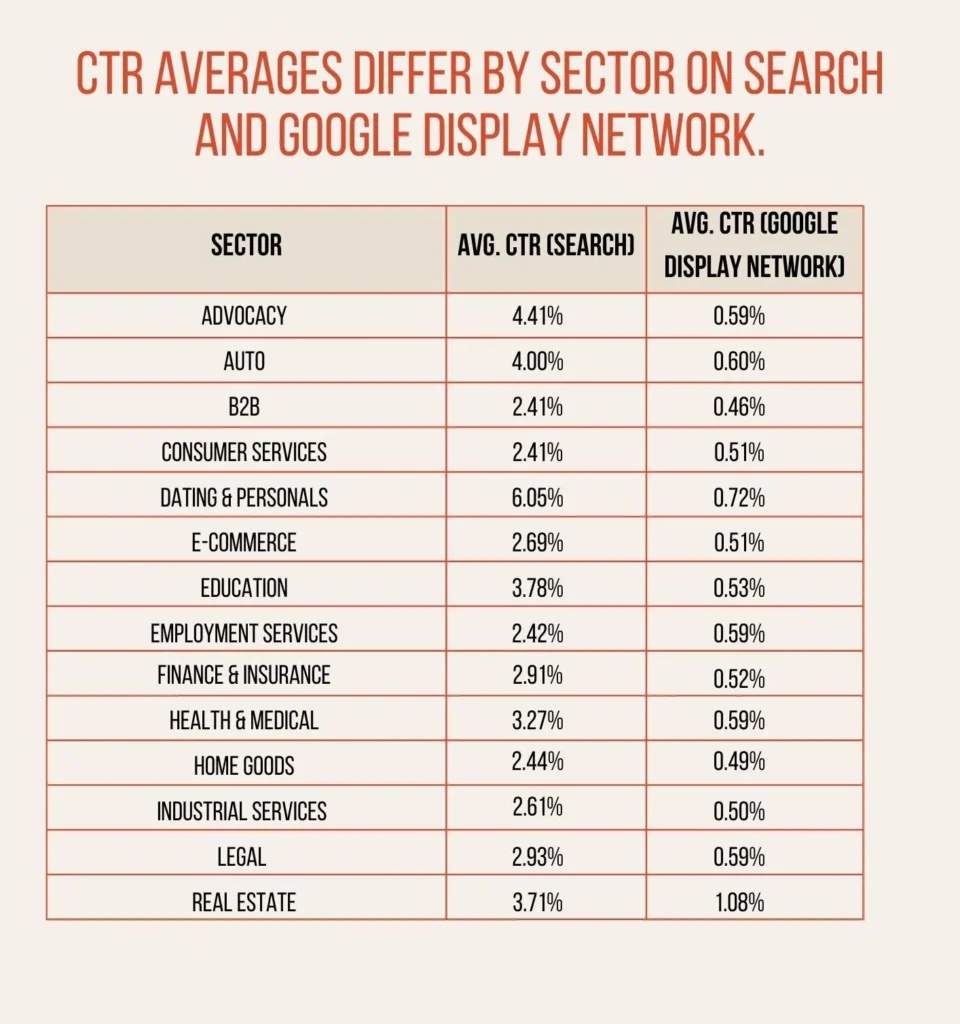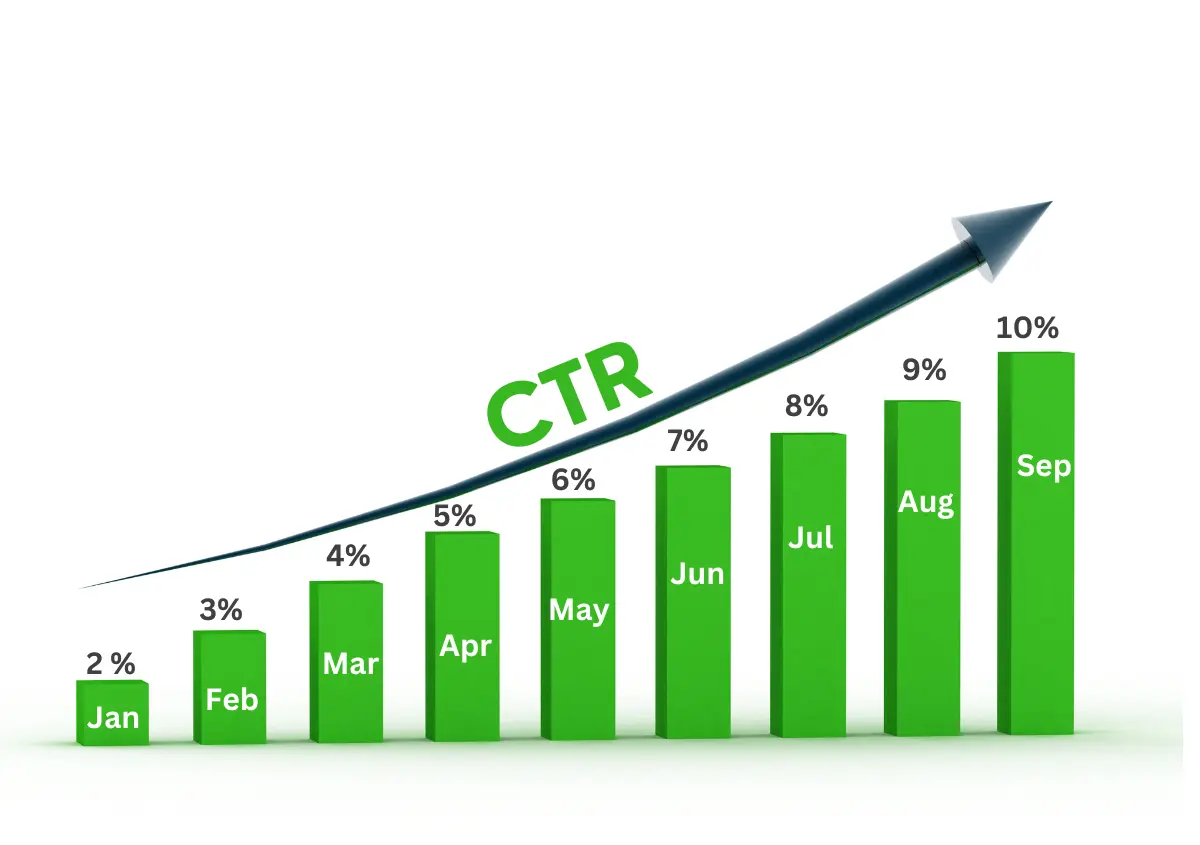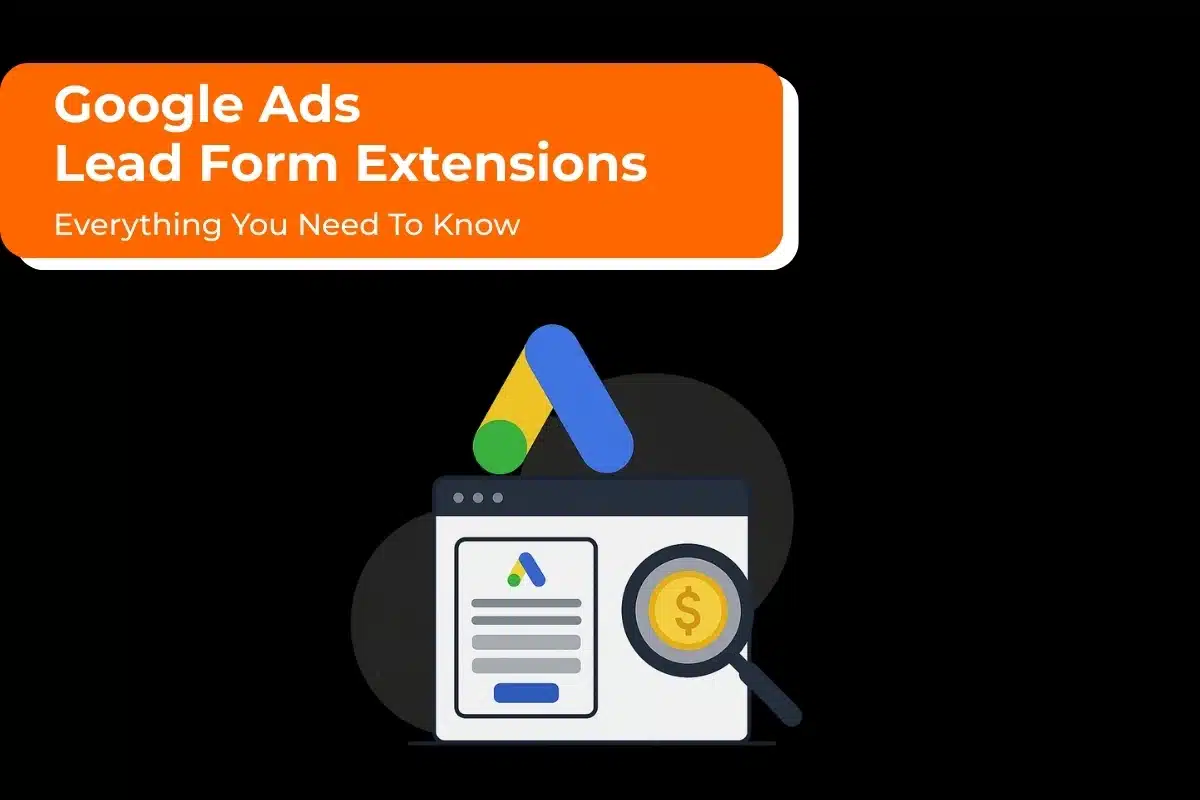You experiment with PPC ads on Google Ads, but your click-through rate isn’t as high as expected. But you launched into it without fully understanding how to develop, organize, and manage a successful campaign.
We get it. Low CTR can be frustrating.
For marketers, click-through rate, or CTR, is crucial. The majority of PPC services, such as Google Ads (formerly known as Google AdWords) and Bing Ads, use your CTR to calculate your cost per click as well as your ad rank. In Google Ads, a greater CTR translates into reduced expenses and a better ranking.
The percentage of total ad views that result in clicks is known as the “click-through rate,” and it is a crucial component of Google’s Quality Score calculation. Based on Quality Score, Google determines your ad position and real cost per click.
Continue reading to learn what constitutes a good click-through rate and 13 strategies for improving Google Ads’ CTR.
What is a Good CTR for Google Ads?
CTR shows you how many people are interested in what your ad has to offer. A conversion is more likely to happen if more individuals visit your website.
So, what can you say is a favorable or good CTR for Google Ads?
1.9% is the average CTR. On the search network, the average AdWords CTR is 3.17%, whereas on the display network, it is 0.46%. To achieve a slightly higher click-through rate than the average, aim for it. On the Google search network, a strong PPC campaign will have a click-through rate of 4%–5%, and on the display network, it will be 0.5%–1%.
Industry-specific average CTRs will vary. In the search network, the average CTR for B2B is 2.41%, whereas on the display network, it is 0.46%. The CTR for real estate is 1.08% and 3.71%, respectively. The CTR will depend on the platform, ad formats, and ad placement. Ads ranking #1, for example, had a CTR of 7.11%. Twitter advertising has a CTR of 2%, and MPU format ads have a CTR of 0.05%.
Divide the total number of clicks by the total number of impressions to find the CTR, which is then divided by 100. For example, if an advertisement receives 2500 impressions and five clicks, your CTR is 5/2500 =.0020 x 100 = 20%.
Average Click-through Rate for Search and Google Display Network

What Should I Do If My CTR Is Poor?
It is important to keep in mind that since this is pay-per-click advertising, not every click on your ad will result in a lead or conversion. However, you will be charged for each time a user clicks on your ad.
If your conversion rate is poor, having a high click-through rate is detrimental since it means you are paying for clicks that won’t generate any leads or profit.
Therefore, the greatest qualifying click-through rate is what you want to aim for rather than the best click-through rate overall.
But there’s more.
The keywords on which you are bidding are another component of this equation. Certain keywords are so expensive that, even if you get conversions from those clicks, your ad spend will not be profitable. Therefore, if possible, you should aim for a high click-through rate on reasonably priced, relevant keywords.
1. Put Freebies or Discounts in the Ad Headline
Special deals and promotions, such as free delivery and discounts, are loved by everybody. However, place them directly in your PPC headlines rather than only adding them in the description. Mostly because searchers often scan the headlines first. Additionally, terms like “free” and headlines with discount numbers usually work well together in people’s minds.
Hence, the headline must attract readers’ attention. Indicate savings or complimentary offerings clearly.
Remember that your customers demand the services or offerings you provide. They will stop looking further if they can get exactly what they want, and that too at a significantly discounted price. If your ad has an enticing title that says “FREE” or “30% DISCOUNT,” people will click on it, increasing your click-through rate and PPC campaign.
2. Bring Up the Pain Points & Add Emotions
Are you aware of your audience’s demands? Can you effectively convey to clients that your offerings can satisfy their customer needs?
Your ad copy should assist your target in identifying demands. It should persuade them that your product or service is the best choice if they already know what they need.
As customers see the benefits of your offering, you receive more clicks when you answer their problems or pain points. Furthermore, those who click on your ads will be qualified leads, leading to a higher conversion rate.
Another important aspect of an ad copy is evolving emotions in customers. Creating emotionally charged ad copy is essential to elevating your click-through rates. However, the key to writing emotive advertising language is to be subtle. There’s no need to use exclamation marks, bold letters, or capitals.
Without Emotions
Here is an example: “The Best Products Available. Buy Now.”
“The Best Products Available” has been used in this. That’s all well and good, but…
With Emotions
Here is an example: “Buy Confidently. Because Quality Products Matter.”
This Ad uses more emotive language, such as “Buy Confidently” and “Because Quality Products Matter.”
The ad copy above is not only more emotionally charged but also focuses more on the benefits. It’s not overly dramatic; it just seems right.
3. Make Your Ad Copy Easy to Skim.
You can be sure that very few ads, especially online ones, are read entirely unless it’s a billboard at a lengthy traffic signal. Make your advertisements basic so that they convey a powerful message quickly. Here’s how to do it:
Don’t repeat the term; instead, use it once in the headline and description.
If you don’t need all the characters, don’t use them.
Don’t use nonsensical acronyms in your advertisement to make it more complicated.
Use clear, readable words that are simple to understand.
4. Include Your Primary Keyword in the Display Path
The display paths for Google Ads follow the slash in your destination URL. Even if they are optional, you ought to utilize them. Utilize them to include your term in the body of your ad. Among the following cases, one stands out from the others. You can convey value or persuade the viewer that you have what they’re seeking by using those display pathways.
5. Add a Call-To-Action
It is not a call-to-action to tell a user that you have what they want or that your offer outperforms that of your rivals. You must truly encourage viewers of your ad to take action. and to take immediate action.
Purchase now.
Download now.
Even if it’s only one or two words, the micro-push may significantly impact.
Better yet, highlight the advantage or a feature in the call to action (CTA), such as “Save Now” or “Speak to a PPC Expert today.”
6. Choose the Appropriate Keywords
Keywords are a major part of your PPC efforts. They allow customers searching for your goods and services to find your advertisements. The ideal keywords to target should have the ideal frequency ratio to the competition. Because your advertising will only show up for keywords that benefit your business, well-selected keywords will attract more qualified prospects.
Make sure you’re targeting the appropriate keywords first. To increase click-through rates, concentrate on the following three categories of keywords:
Keywords with a commercial aim are those that consumers type in intending to make a purchase, such as “automatic washing machine” or “best PPC agency.” Avoid educational keywords like “What is a PPC agency,” which will decrease CTR and/or lead to unnecessary spending.
Branded keywords provide even more potential than merely promoting your own business. Consider targeting partners’ or competitors’ brands, as well as other brands that your target audience could look up while purchasing.
Local keywords: Due to the significant commercial intent of local searchers, local keywords such as “Chicago personal yoga expert” generally provide high click-through rates.
Another is using wide-match keywords to display your ads to as many prospective customers as possible is an alluring option. However, doing so raises the possibility of receiving unqualified leads and seeing greater bounce rates. For your PPC campaign ad that is in front of real customers, exact match or phrase types are the best options.
The keywords and phrases that your ads will display are reduced by phrase and exact match types. These match kinds guarantee that the clients who are most likely to be interested in and benefit from your adverts will see them.
7. Make Use of Negative Terms/Keywords
Maintaining your click-through rates requires this. The terms you want Google to display your ad under are known as negative keywords. Thus, if you sell new cell phones, you would set the keywords “refurbished” or “used” as negative. This way, those who are unlikely to click on your ad won’t see it.
Negative keywords aren’t relevant or helpful for your business. You can manually block them to prevent your ad from showing for certain bad terms.
Utilizing match type and blocking negative keywords can reduce the number of impressions. The lower your impressions, the higher your click-through rate (CTR), which is calculated by dividing the number of clicks by the impressions multiplied by 100.
8. Employ Dynamic Keyword Insertion, But Moderation Is Crucial
If you have enabled dynamic keyword insertion (DKI), Google will automatically add the term that triggered your ad to your headline or ad content. This helps, but it does not go far enough.
Depending on the searcher’s query, you may dynamically insert a keyword into your ad content using dynamic keyword insertion.
Let’s take an example: We have keywords like these in our Ad Group for my sofa store: sofas, leather, couches, finest leather couches, and so on.
Using dynamic keyword insertion, we can display the word couches for users searching for “couches,” the phrase “leather couches” for users searching for that term, and so on, right there in the ad text. DKI tailors the ad according to the precise search term.
In summary, because the ad is dynamically modified to reflect the user’s actual search query, dynamic keyword insertion enables you to offer searchers a more relevant ad.
9. Limit the Audience You Are Targeting
You could also want to review your audience targeting if you aren’t using search or keyword-targeted advertisements (or if you are and you’re layering audiences on top of that). Even if you aren’t receiving as many clicks overall, you could precisely target your ad text and increase your click-through rate by precisely defining your audience.
10. Add the Google Ads Extensions
Ever notice an ad that leads to particular pages on a company’s website or a way to contact them? Those are Google Ads addons on PPC ads.
Extension formats consist of links to the website, CTA buttons, extra content, and location data. Google ads will determine which extensions appear based on the search conducted.
Extensions benefit customers and increase the likelihood that they will click on your ad. They raise ads’ value, CTR, and visibility and provide customers with more avenues for interaction with your company.
Google Ads extensions can increase the size of your advertisement on the SERP and increase its click-through rate.
11. Place a Higher Bid
To have your ads show up when a user types in certain keywords and phrases, you must bid on those terms in Google AdWords. The higher your bid, the more competitive the term. Google chooses and displays the advertisements with the highest bids. You must place greater bids if you want your PPC campaign to be more successful. Your click-through rate (CTR) rises when customers who are searching for particular keywords see your adverts because they are more relevant.
12. Try Testing More Ads
After doing some math to determine the relative number of ads having a click-through rate that was greater than usual, here is what was discovered.
Best 15%: These ads appear in one out of every six or seven ads and have a two-fold higher click-through rate.
Top 5%: These ads appear once per twenty ads and have a CTR that is three times higher.
Top 1%: These appear once per hundred ads and have a six times better CTR.
Yes, one hundred commercials. No, testing a hundred ads is unnecessary, but testing many of them is.
Yes, responsive search advertising will test your ad text by matching and mixing headlines and descriptions, but no, you still need to perform your own testing.
13. Pause the Bottom Third of Your Account
So, a summary.
Excellent click-through rate = high.
Not great = low click-through rate.
How about you pause the lowest third of your account and use that money again for remarketing?
These are your garbage performers—poor CTR and low impression share—a dead weight holding you back.
The Display Network offers far reduced cost-per-click, and if you use the display for remarketing, you may get conversion rates that are comparable to or sometimes greater than those of search ads.
It would be a great start to more efficiently growing your Google ads effort if you could pause the costlier search ads—the bottom third of your account—and redirect that budget to even out the average-performing remarketing and display ads.
Need a Good CTR For Google Ads Campaign? Contact Us
Do you require a Good CTR for Google Ads? You can begin with your own immediate, free account assessment. But to assess the condition of your Google Ads account and spot improvement opportunities, you need Google Ads experts who know exactly what they are doing.
Contact us if you need assistance with your Google ads.






